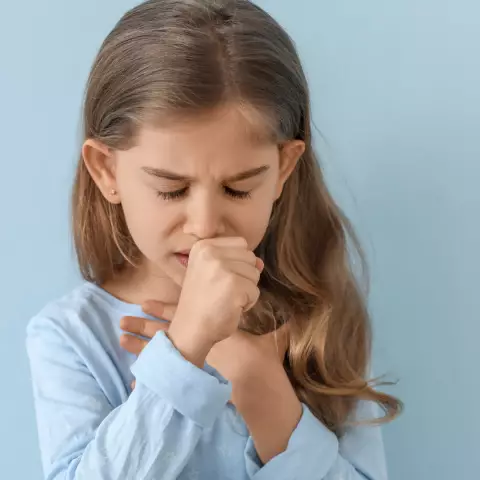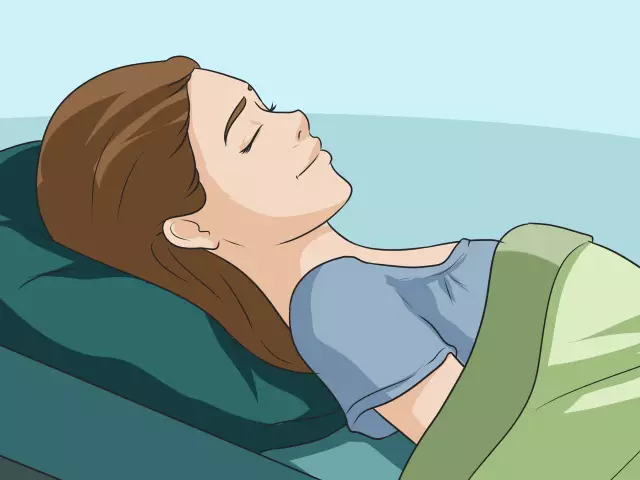- Author Curtis Blomfield [email protected].
- Public 2023-12-16 20:44.
- Last modified 2025-01-23 17:01.
All parents react differently to a cough in babies - someone does not pay attention and ignores, especially when there is no temperature and runny nose, while others immediately rush to treat their child with all available means. All two types of parents go to extremes, because before you start treating an infant, both at 3 months and older, you need to find out the root cause of such a cough.

What is a cough?
Cough is a reflex that helps to clear the respiratory tract from any foreign substances, these can be dust particles, crumbs, accumulated mucus, allergens, pathogenic bacteria, viruses. Babies cough with a sharp loud exhalation, in which air leaves the respiratory tract at high speed.
If the baby has a cough and fever, you should immediately consult a doctor.
Types of cough and its causes
Given the presence of factors that cause coughing, it is usuallydivided into physiological, which is needed to clean the respiratory tract and pathological, which appears with various diseases.
Cough in infants is a symptom of these diseases:
- pharyngitis;
- angina;
- laryngitis;
- ARVI;
- sinusitis;
- bronchitis;
- pneumonia;
- tracheitis;
- tuberculosis;
- allergy;
- bronchial asthma;
- whooping cough and other infections;
- helminth infection.
Wet cough
It happens that at the same time there is a cough and a runny nose in the baby. If you observe the discharge of sputum, then you can distinguish such types of cough as wet (also called wet or productive) and dry (no sputum). It is considered normal for a newborn baby two months or older to cough up phlegm in the morning, as it can accumulate during sleep. During the day, there will be no more coughing, and the general condition of the child will remain unchanged.

Dry cough
Watching the sound of a dry cough in a baby, you can define it as:
- superficial - found in pharyngitis;
- barking - a loud cough that sounds like a dog's barking that usually occurs with laryngitis;
- pulmonary - paroxysmal, exhausting cough.
Is it dangerous to cough in a baby without fever?
Causes other than sore throat
Infants may begin to cough ifa foreign object has entered the respiratory tract, for example, a small toy or some small part of it. Also, in addition to the sudden appearance of a cough, the child may lose his voice, his skin will turn blue, and breathing will become difficult. Such situations become a good reason to immediately call an ambulance.
The appearance of a cough in a baby at about 5 months old can be caused by an allergic reaction. A child can cough up dust, pollen, down pillows, allergens from food, and other objects and substances. In order to deal with such a cough in a child, it is necessary to detect the allergen and eliminate its effect.
Also, the cause of cough in infants, in the absence of respiratory diseases, may be helminthiasis. Some worm larvae can enter the lungs, developing in the child's body. During a cough, they can pass into the gastrointestinal tract with mucus, and then get to the intestines.
It is also important to note that the cause of a dry cough in a child can be dry air in the room. In these cases, the problem can be easily solved by putting a humidifier in the room, or another source of moisture (wet towels, water containers).
Children may cough while eating when milk comes in very quickly. You can eliminate such a cough by changing the position when feeding. Bottle fed babies need a pacifier change.
But when snot and cough appear simultaneously in a baby, this may indicate a viral infection.

Dangerous symptomscoughing
Parents should be alert and take their child to the doctor as soon as possible in the following cases:
- child coughs up green or red sputum;
- cough appeared suddenly and does not stop;
- cough appears at night in the form of attacks;
- along with a cough, the baby has wheezing that can be heard from afar;
- cough continues for more than three weeks.
Let's figure out how to treat a cough in a baby without fever.
Treatment
If a cough of any kind occurs in a baby, it is necessary to first find out whether such a manifestation is normal or if it is a disease. To do this, you need to take your child to the doctor, because any pharmaceutical cough remedies for children under one year old can only be used after the appointment of a pediatrician or ENT.
In addition to medicines, in the treatment of cough used:
Drainage massage. It should be carried out for children whose body temperature is normal, from 5-6 days of illness, in order to improve sputum discharge. With this massage, the child's head is placed below the body. First, massage the back, then the chest. After the end of the massage, the child should be wrapped up and put to bed, regularly change the position of his body

- Inhalations. They can be steam and nebulizer, depending on the option. It is necessary to hold the child over the steam very carefully in order to eliminate the risk of burns. In infancy in a nebulizer for inhalation withoutappointments of a pediatrician, you need to pour only saline or Borjomi.
- Folk remedies for dry and wet cough in infants. These include herbal decoctions, rubbing with badger fat, cakes with honey.
Overview of the best funds
Among the medicines that a doctor can prescribe for a cough for a baby, there are drugs of the following groups:
- Expectorants. They help to improve mucus discharge. Babies under the age of one are prescribed Linax, Gedelix, Prospan, Gerbion, Bronchipret and licorice root syrup.
- Antitussive drugs. They can reduce the activity of the cough center and are prescribed only for severe debilitating dry cough. You also need to know that such drugs cannot be combined with expectorants.
- Antihistamines. They are usually prescribed in case of allergic cough.
- Mucolytics. These drugs are able to reduce the viscosity of sputum, which will help it to be better discharged. These approved for use in infants include the drug "Ambroxol".
- Antibiotics. They are prescribed for bacterial infections that manifest as a cough, such as sore throat or pneumonia.
Breast fees
It is possible to use medicinal herbs for the treatment of cough, combine them in various combinations as breast fees. These fees may include plantain, sage, licorice, oregano, anise, marshmallow, coltsfoot, and other herbs. One way or another, in order to avoid allergies and other side effects, experts recommend giving decoctions to young children with onecomponent.
Chamomile is a medicinal herb with antimicrobial and anti-inflammatory effects and is often taken up to a year old. If you are brewing chamomile for a child for the first time, you need to give him a few drops of this natural remedy in order to check the reaction of the baby's body.

To prepare this decoction, you need to take one tablespoon of dried flowers and a glass of boiled water, cover it with a lid and strain after 10 minutes. Such chamomile tea should be given three times a day after feeding in half an hour in an amount of no more than 30 ml for babies.
Chamomile can also be used for inhalation. To do this, you need to brew dried flowers and let stand for 40 minutes, then pour the broth into a liter of boiled water, then bring the child to the container and let him breathe over the steam for 5-10 minutes.
It is also possible to carry out so-called passive inhalations. To do this, pour a little boiling water into the bath, so that the bathroom is filled with steam. Then go into the room with the baby and sit in it for about 10 minutes. And if the child does not have allergic reactions, then eucalyptus oil can be added to the bath.
What else is included in the treatment of cough in infants?
Cough massage benefits
In some cases, the doctor may prescribe physical therapy for the child. An actual technique in the treatment of cough is massage. There are techniques that are designed specifically for babies and use them not only in the treatment of colds, but also inpreventive purposes. Commonly used methods are:

- Make light patting and tapping in the chest area. Such movements help to remove excess phlegm from the respiratory tract.
- They rub their feet with warming ointments. First, ointment is applied to the skin with light strokes, then rubbed until the skin is pink, after that they move on to the calf muscles.
- Percussion massage - tapping on the back with the edge of the palm. The child is placed on his stomach, his arms are raised up, his head is located below the part of the body. After this massage (its duration is not more than five minutes), the child's oral cavity is checked. If mucus has accumulated there, it is mechanically removed with a finger wrapped with clean gauze.
- Carry out a warming massage in the chest with special ointments. The procedure lasts until a slight reddening of the skin, which indicates an improvement in blood circulation. After the child is wrapped or dressed to keep as warm as possible.
Massage has contraindications, which include:
- allergic reactions;
- exacerbation of rickets;
- fever;
- epilepsy;
- damage to the skin;
- blood clotting disorders and heart disease.
How well the massage goes, you can find out by the reaction of the child, touching should be pleasant for him. You can not massage if the child feels discomfort.
We looked at how to treat a cough in a baby.
Tipsparents
Here are some more useful tips to follow:
- it is often necessary to ventilate the room where a small child is, especially if he has a cough, as he always needs fresh air;
- change the position of the baby in the crib and often pick him up;
- it is desirable that the temperature in the room be no higher than 22 degrees;
- in order for the child to drink more liquid, offer him a new beautiful or bright mug;
- if the baby's body temperature is normal, you need to go for a walk with him;
- if your baby has a runny nose in addition to coughing, rinse his nose with water and sea s alt.

If you follow all these simple rules, the child will get sick less often, and also recover much faster. You can also consult with a specialist about proper care for your baby.






